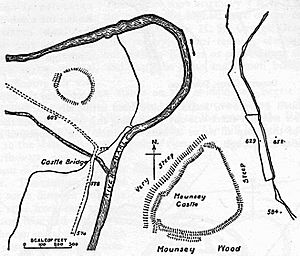Mounsey Castle facts for kids
Quick facts for kids Mounsey Castle |
|
|---|---|

Plan of Mounsey Castle
|
|
| Location | Dulverton, Somerset, England |
| Area | 1.75 hectares (4.3 acres) |
| Built | Iron Age |
| Official name: Mounsey Castle and associated outwork 100m to the north | |
| Reference no. | 35638 |
| Lua error in Module:Location_map at line 420: attempt to index field 'wikibase' (a nil value). | |
Mounsey Castle is an ancient site from the Iron Age in Somerset, England. It's not a typical castle with stone walls and towers, but rather an "earthwork." This means it's a defensive area made mostly from earth and stone banks. It covers about 1.75 hectares (that's roughly the size of two football fields!).
You can find Mounsey Castle north-west of Dulverton. It's officially protected as an ancient monument because it's so important to history. However, it's also on the "Heritage at Risk Register," meaning it needs care to keep it safe for the future.
The name "Mounsey" comes from the Monceaux family. They were powerful local landowners, known as lords of the manor, during the Middle Ages.
This earthwork is surrounded by a strong stone wall, called a rampart. This rampart is between 1.5 and 2 meters high. There's an entrance on the western side. For most of its length, it has one rampart (this is called univallate). But where the ground isn't as steep, on the eastern and southern sides, there's a second rampart for extra protection. Inside the hillfort, you can still see the remains of a stone building. Experts think this was probably a hut used by people who made charcoal.
Mounsey Castle sits high up, looking over the River Barle.
What is a Hill Fort?
Hill forts like Mounsey Castle were built a very long time ago. They appeared in Britain during the Late Bronze Age and Early Iron Age. This was around the start of the first millennium BC.
Historians and archaeologists have long discussed why these forts were built. Some thought they were military bases, perhaps to defend against invaders from Europe. Others believed they were built by the invaders themselves. Another idea was that they were a response to social problems. As more people lived in Britain, there was more pressure on farming land. This could have led to conflicts.
A popular idea since the 1960s is that the discovery of iron changed society. Iron ore was found in different places than the tin and copper used for bronze. This changed how people traded goods. Old leaders might have lost their power, and new groups gained influence.
Archaeologist Barry Cunliffe believes that a growing population played a big part. He suggests that hill forts offered places for communities to defend themselves. This was especially true when tensions led to open fighting. He doesn't think they were built because there was a constant war. Instead, they were useful strongholds when problems arose. Some forts were attacked and destroyed, but this wasn't the only reason they were built.

